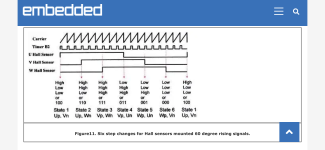TommyCat
10 kW
Thoughts... not in any particular order.
From your description of switching between 3.3vdc and 0vdc. (no stray linear voltages in between) And looking up the data sheet on this type hall sensor. It looks to me that it is a Unipolar type hall sensor. Which works well on some BLDC systems. Proven with use on your other controller.
With that in mind... Is your Chinese controller a sensored and non-sensored controller? I.E. will your motor work with the hall sensors unplugged?
Reference: https://www.digchip.com/datasheets/parts/datasheet/029/A3144-pdf.php
SS41F is a commonly used Bipolar hall sensor for Ebike motors.
Datasheet: https://www.mouser.com/catalog/specsheets/hwsc-s-a0001295895-1.pdf
Does your new controller software AUTOMATICALLY configure your sensors to windings? Determining the angles and degrees?
If not have you set them up correctly?
Please take a longer and closer look at the testing thread...
https://electricbike.com/forum/foru...-motor-s-phase-wiring-hall-sensors-and-wiring
I try to explain how the hall reference signal from the controller is sunk to ground by the motor's hall sensor.
Now this signal can be 5vdc, or it can be the 3.3vdc that you are showing now.
These values would be the high water mark, with the activated hall sensor sinking the reference signal to ground for the 0vdc, or low water mark.
The resistors are only required when you are testing the motor's hall sensors when they are DISCONNECTED from the controller.
They are indeed internal to the controller.
I stand by my recommendations on how to test.
Sorry, I didn't start by reading this entire thread. Thought it was another one I'd posted too. Alot of this has been covered previously...
bhagudunk said:Current hall sensor installed is A3144 (linear type)
From your description of switching between 3.3vdc and 0vdc. (no stray linear voltages in between) And looking up the data sheet on this type hall sensor. It looks to me that it is a Unipolar type hall sensor. Which works well on some BLDC systems. Proven with use on your other controller.
With that in mind... Is your Chinese controller a sensored and non-sensored controller? I.E. will your motor work with the hall sensors unplugged?
Reference: https://www.digchip.com/datasheets/parts/datasheet/029/A3144-pdf.php
bhagudunk said:...and I already bought 41F type (bipolar) from local online marketplace.
Is it OK with this type?
SS41F is a commonly used Bipolar hall sensor for Ebike motors.
Datasheet: https://www.mouser.com/catalog/specsheets/hwsc-s-a0001295895-1.pdf
bhagudunk said:Note : current hall sensor works well with my old China 45 amps controller but reported faulty with my new Votol em100.
Does your new controller software AUTOMATICALLY configure your sensors to windings? Determining the angles and degrees?
If not have you set them up correctly?
bhagudunk said:QS document stated above clearly indicate that QS Motor (which is the best match of Votol controller) using bipolar hall sensor that give 0V (off) and 5V (on) output.
Back to the ground, one thing I still don't know is whether I have to use 10K resistor soldered to +5V and the output leg of each hall sensor or not.
I guess the controller has this component attached internally.
Please take a longer and closer look at the testing thread...
https://electricbike.com/forum/foru...-motor-s-phase-wiring-hall-sensors-and-wiring
I try to explain how the hall reference signal from the controller is sunk to ground by the motor's hall sensor.
Now this signal can be 5vdc, or it can be the 3.3vdc that you are showing now.
These values would be the high water mark, with the activated hall sensor sinking the reference signal to ground for the 0vdc, or low water mark.
The resistors are only required when you are testing the motor's hall sensors when they are DISCONNECTED from the controller.
They are indeed internal to the controller.
I stand by my recommendations on how to test.
Sorry, I didn't start by reading this entire thread. Thought it was another one I'd posted too. Alot of this has been covered previously...


